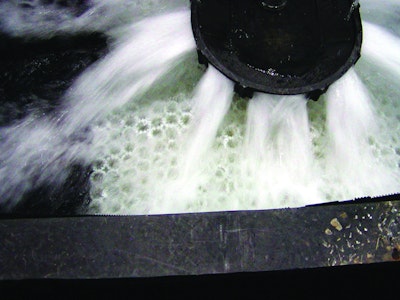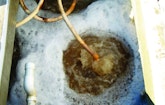
A Cromaflow sequencing batch reactor from Cromaglass Corp. using submersible pumps to provide air and mixing with a venturi system receiving air through intake pipes from the atmosphere. (Photos courtesy of Sara Heger)
Interested in Systems/ATUs?
Get Systems/ATUs articles, news and videos right in your inbox! Sign up now.
Systems/ATUs + Get AlertsTo maintain aerobic conditions, large quantities of oxygen must be provided. If the influent to the ATU has an ultimate BOD of 100 mg/L, then 100 mg of dissolved oxygen per liter of influent must be provided to satisfy the oxygen demand. The primary function of the aeration system is to transfer oxygen to the liquid at such a rate that dissolved oxygen never becomes a limiting factor.
Oxygen is only slightly soluble in wastewater. Natural aeration cannot meet the demand of this high-rate unit process in a saturated environment. Therefore, oxygen transfer must be engineered into aerobic treatment units to maintain a minimum residual of 1 mg of dissolved oxygen per liter of wastewater.
The movement of oxygen from the gas phase (bubble) to the liquid phase (in solution) is absorption. There is a concentration gradient between the atmosphere and the wastewater. This gradient is created when there is a difference in the equilibrium concentration in the two phases.
The desire to obtain equilibrium drives the transfer of atmospheric oxygen into the wastewater.
OXYGEN TRANSFER
The saturated concentration of dissolved oxygen changes with temperature, barometric pressure, salinity and the concentration of wastewater impurities. Designers of ATUs strive to maximize the contact interface (surface area) between the gas and liquid phases to maximize the opportunity for oxygen transfer.
Aeration units are evaluated on the mass of oxygen transferred per unit of air introduced to the wastewater. Standard oxygen transfer efficiency refers to how efficiently the dispersed oxygen combines with wastewater for the aeration process to occur. The oxygen transfer efficiency of aerators is the result of two factors:
Surface area: A mass of many small bubbles has a much larger cumulative surface area than a few larger ones. This increased surface area allows for a higher rate of oxygen transfer as the air and wastewater come into contact across the surfaces of the bubbles.
Speed: Smaller bubbles rise at a slower rate than larger ones. This slow rate of speed results in a greater amount of contact time between air and wastewater and permits more oxygen to be distributed throughout the wastewater column. The increased time for oxygen transfer results in greater transfer efficiency.
The goal is to maximize the mass of O2 transferred per unit of energy consumed by the device. Combining mixing with aeration is the most common method of maximizing energy efficiency. Turbulent mixing is required to maximize the opportunity for microbes to encounter both soluble organic compounds and dissolved oxygen. If steady-state conditions can be maintained, the oxygen transfer rate is equal to the rate of consumption by the microorganisms.
AERATION METHODS
For most ATUs, the actual SOTE is proprietary information. Manufacturers market-specific ATU models based on organic and hydraulic loading. The aeration device is rated for a given unit to provide sufficient dissolved oxygen for the given range of input oxygen demands (organic loading). Aeration is provided by one of the following methods:
Mechanical aeration - introduction of air via mechanical means.
This is a mechanical method of injecting air into orifices in pipes and plates. Streams of air transfer oxygen and provide vigorous mixing of tank contents. Surface mixers or subsurface mixers with draft tubes where air is drawn down a hollow shaft and sparged into the fluid are also used. As the shaft spins, a venturi-type effect creates a vacuum down the shaft and injects air into the wastewater.
The mixing devices must balance the need for agitation, while minimizing the shearing of the floc. The bubbler or stirrer keeps the wastewater agitated so solids cannot settle out, floating materials stay mixed, and poor settling conditions in the clarifier can result. With mechanical aeration, you generally get vigorous mixing and oxygen transfer.
The systems are relatively simple and low-cost. The downside is that the mixing and oxygen transfer may not be consistent throughout the tank; they have a low SOTE, resulting in more strain on the blowers and higher operating costs due to higher maintenance needs.
Diffused aeration - introducing air bubbles under pressure into a treatment unit using a compressor, blower, and diffuser.
Submerged devices, typically disks or tubes, inject air into the effluent. The smaller the bubble, the greater the oxygen transfer rate into the effluent. Additionally, bubbles formed deep within the chamber will have more pressure to drive the oxygen transfer and more contact time with the air-water interface. There are various classes of diffusers based on the diameter of the bubble:
- Coarse: 2 – 8 mm
- Fine: 0.2 – 3 mm
- Micro: < 0.2 mm
Coarse bubbles have the advantages of being less likely to foul, creating vigorous mixing, being durable, and having relatively low maintenance requirements. The larger holes of coarse bubble diffusers mean they are less likely to be fouled with bacteria or biosolids. This results in less back pressure on the blower, which creates wear and tear.
The larger bubbles have more volume, displace more wastewater and produce more power for mixing. Biosolids are kept in suspension and are less likely to form unwanted sludge. There are downsides to coarse bubble diffusion, which relate to the large bubble diffusers having a SOTE of less than 1%. Even though they have increased vertical mixing power, coarse bubble diffusers disperse less oxygen into the wastewater for less efficient aeration, typically achieving 50% or less the efficiency of fine bubbles. The amount of compressed air is greater and requires more power to achieve similar results.
MIXING IS VITAL
The smaller bubbles produced by a fine-bubble diffuser can accomplish the same amount of oxygen transfer with about half as much air as a coarse bubble diffuser would require. Fine-bubble diffusers also use less energy, but there are some downsides to fine-bubble diffusers. They are more likely to become clogged with bacteria and organic waste.
If sludge builds up on the diffuser, it impairs the function and reduces the aeration efficiency. It also creates back pressure, which increases wear and tear on the blowers. There is often more maintenance with fine-bubble diffusers due to increased fouling. While efficient for aeration and oxygen transfer, the smaller bubbles produced by fine-bubble diffusers are poorer at mixing. Their smaller volume than coarse-bubble diffusers mean they cannot displace the same amount of liquid.
Mixing is vital for keeping biosolids in suspension so they cannot settle in the water and form sludge, which makes the treatment process less efficient and is costly and time-consuming to remove. Mixing is also necessary for bringing microorganisms into contact with solid organic matter to break it down. Fine-bubble diffusers provide less power to facilitate this process.
Fine bubbles are the smallest option available with diffusers and are mostly used with membrane bioreactors in the septic system industry. These diffusers have the highest SOTE and require less energy. The downside is that they have the highest risk of fouling, are more expensive, can create back pressure when fouled, and may create mixing challenges as the bubbles rise too slowly.
THE BOTTOM LINE
There are many options when it comes to how to get air into an ATU, with various advantages and disadvantages. Efficiency, upfront and long-term costs, maintenance and electrical costs must be considered.









